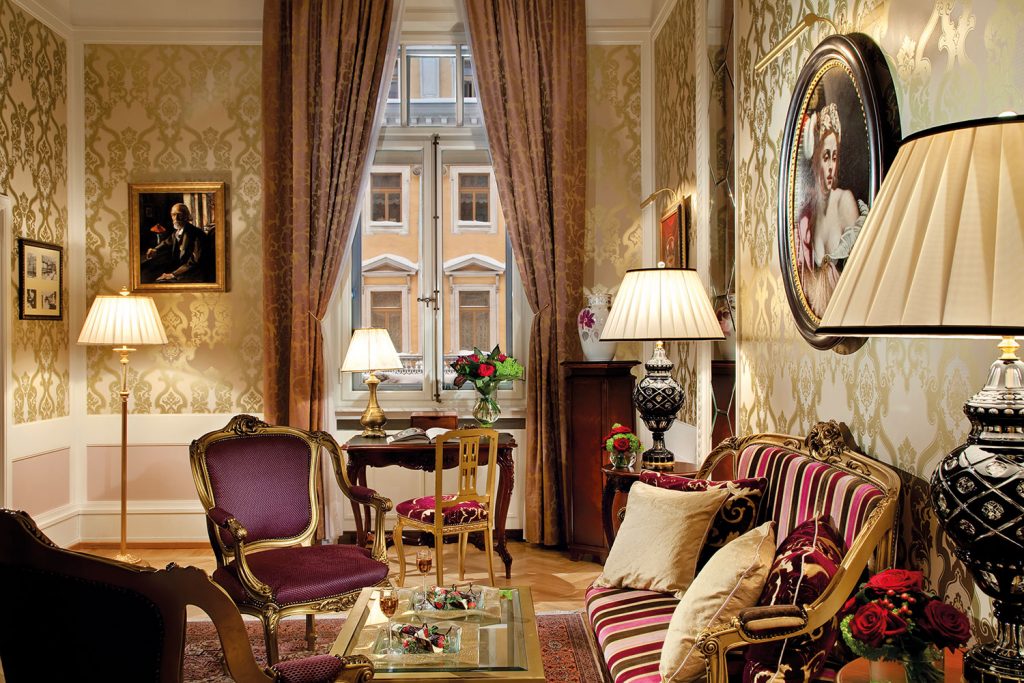Essentials checks into Saint Petersburg’s oldest restaurant, L’Europe at the Tsarist-era Grand Hotel Europe, to relive its golden heritage and sample some of the finest vodkas and caviar served today.
Saint Petersburg’s oldest restaurant, L’Europe, opened in 1905 within the Belmond Grand Hotel Europe. The hotel today retains several unique historic suites that evoke classic turn-of-the-century Tsarist elegance and explain why the hotel once attracted Russia’s aristocracy and well-to-do, including the composer Tchaikovsky.
When the Siege of Leningrad began in September 1941 the restaurant was turned into an army hospital surgical ward, but later resumed serving classic haute cuisine, and has done so ever since.
Its magnificent centrepiece, a stained-glass window depicting Apollo in his chariot, survived the upheaval of revolution and war and still casts its magic over diners.
‘It’s a fascinating story; there’s so much history and romance here,’ says Alexander Dmitriev, Saint Petersburg’s first vodka and caviar sommelier.
Alexander started work at L’Europe six years ago, his knowledge and passion for the much-loved spirit earning him the title of vodka and caviar ‘master’. He believes vodka reflects the heart and soul of his homeland, Russia, and that great vodka evokes good dreams while poor vodka brings only bad dreams and a headache if you overindulge.
‘It’s when you drink bad vodka – even a little – that the reputation and romance of the spirit is destroyed,’ he says.
Alexander is keen to dispel what he calls unkind myths about the often-misunderstood spirit. ‘Sometimes producers use some marketing tricks to increase the price of vodka such as a very expensive bottle, for example,’ he says. ‘Cheap vodka can be filtered in the incorrect way and it can greatly influence how you feel the next day. That’s often why people blame vodka for bad headaches.’
Alexander loves to guide guests through the subtleties of vodka tastes, accompanied by a caviar degustation, in the designated caviar and vodka bar while explaining the spirit’s heritage.
The bar, close to L’Europe, is an intimate art deco dining room where 50 icy-cold vodkas and more than a dozen varieties of fresh malossol caviar are served. It features an unusual collection of home-infused liqueurs, the symbol of Russian gastronomic culture.
‘This collection was accumulated over the years from a variety of sources including recipes from old books and family recipes,’ Alexander says. He has created some of the tinctures in the restaurant and at home, including pear brandy, orange vodka liqueur, raspberry and plum brandy, fruity, berry and citrus vodka.
The best for hangovers, he says, is a Far-Eastern recipe: vodka infused with pine nuts, garlic and peppers. There’s also one that’s good for colds – ginger vodka with lemon and honey.
‘My favourite is a vodka I distilled myself at home from apples and plums,’ he says. He also likes Imperial Collection Gold, filtered with honey, and the Imperia and Beluga vodkas from Siberia.
Alexander can still recall the magical moment when he fell in love with vodka: ‘I tried homemade vodka, a type of distillate, when I was 15 in the countryside in the middle part of Russia and it was very good and since then I have been fascinated by its history and the stories that go with it.
Vodka is a very special drink and plays a very important part in traditional Russian life and is present at all important ceremonies where it is drunk each time in one mouthful from tiny glasses.
We toast to health, family, love and one for the road and it is always taken with tasty snacks – you need to deeply exhale and then drink it in one gulp and, if you drink it correctly, half a minute later you will feel a wonderful heat in your chest.’
The accompanying caviar degustation starts with the signature dish Egg in Egg, a truffle-flavoured scrambled egg topped with Ossetra caviar. Alexander points out the taste nuances of three different caviars, Beluga, Astrakhan and Sevruga, that are served with blinis, sour cream and finely grated hard-boiled egg.
He is also passionate about his home town and says visitors always want to stay longer in historic Saint Petersburg than planned. You need stamina to discover the many treasures of a city that lives up to its name as a grand Russian diva.
Taking centre stage is the magnificent State Hermitage Museum, mainly located in the Winter Palace where Catherine the Great started her extensive art collection in 1764. Wear comfortable shoes and be prepared to walk, for there are 360 rooms in the palace and adjoining buildings. Must-sees include magnificent work by Da Vinci, Rembrandt and Caravaggio, Greek and Roman antiquities, jewellery that dazzles and architecture that evokes awe and admiration.
But it’s not only Saint Petersburg’s sense of history, golden domes, glittering spires, gilded palaces and fountains that seduce travellers; there are surprises around every corner. Home to five million people, the city was once the imperial capital of Russia and has endured a bloody background of revolution and change.
To get a real feel for the city, stride out along its most famous street, Nevsky Prospekt, where you will pass the Russian Library, churches, shopping malls and souvenir shops full of matryoshka nesting dolls, painted umbrellas depicting tourist attractions, and embroidered shawls.
A canal cruise is a great way to see the sights and give your feet a break and, if you are a night owl, watch the city’s many bridges across the River Neva rise at 1.30am to let ships through.
Back at the hotel, I head to the heritage-listed Lobby Bar with its exquisite art nouveau decor, sink into a leather chair and order a cocktail worthy of any diamond-clad diva from the past.
Belmond Grand Hotel Europe
1/7 Mikhailovskaya Ulitsa, Saint Petersburg
www.belmond.com/grandhoteleurope



Comments are closed.